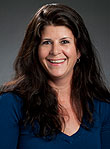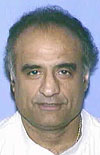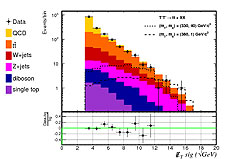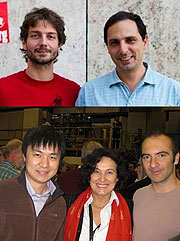|
Have a safe day!
Thursday, Oct. 13
1:30 p.m.
Particle Astrophysics Seminar - One West
Speaker: Miguel Ramirez, Universidad Politecnica de Valencia
Title: Undersea Neutrino Telescopes ANTARES and KM3NeT
2:30 p.m.
Theoretical Physics Seminar - Curia II
Speaker: Markus Luty, University of California, Davis
Title: Superconformal Technicolor and Partial Higgs Compositeness
3:30 p.m.
DIRECTOR'S COFFEE BREAK - 2nd Flr X-Over
THERE WILL BE NO ACCELERATOR PHYSICS AND TECHNOLOGY SEMINAR TODAY
Friday, Oct. 14
3:30 p.m.
DIRECTOR'S COFFEE BREAK - 2nd Flr X-Over
4 p.m.
Joint Experimental-Theoretical Physics Seminar
Speaker: Anyes Taffard, University of California, Irvine
Title: New Results from ATLAS
8 p.m.
Fermilab Lecture Series - Auditorium
Tickets: $7
Speaker: Dr. Tony Wasserman, Carnegie Mellon University
Title: The Rise of Free and Open Source Software
Click here for NALCAL,
a weekly calendar with links to additional information.
Upcoming conferences |
|
Thursday, Oct. 13
- Breakfast: Apple sticks
- Tomato Florentine
- BBQ pork sandwich
- Smart cuisine: Kielbasa & sauerkraut
- Smart cuisine: Chicken marsala
- Smoked turkey melt
- Assorted sliced pizza
- Southwestern chicken salad w/ roasted corn salsa
Wilson Hall Cafe Menu
|
|
Friday, Oct. 14
Dinner
Closed
Wednesday, Oct. 19
Lunch
- Garlic soup
- Muffuletta
- Bread pudding w/ bourbon sauce
Chez Leon Menu
Call x3524 to make your reservation. |
|
Fermilab welcomes Tara Turner to the Benefits Office
|
 Tara Turner Tara Turner
|
There’s a new leader of the Benefits Office. Tara Turner, the new benefits manager at Fermilab, joined the Workforce Development and Resources Section in late August. Her goal is to bring solid benefits packages to Fermilab employees.
“I love the laboratory. I love the environment,” Turner said. “The people here have been very nice and welcoming. It’s a very positive, employee-focused work environment.”
With a career in benefits management spanning 16 years, Turner brings not only a wealth of experience but a new approach to the department. Before taking the lead role at the Benefits Office, Turner managed the North American Human Resources department at the German automaker Porsche. She hopes to apply the successful benefits management and financial skills she gained at Porsche to providing efficient and valuable benefits packages to Fermilab employees. Another goal is to continue to bring solid benefits packages to Fermilab employees and look for areas of improvement.
“Physics is really outside my area. I’m used to talking about services and products the employer provides,” she said, noting that the new physics culture will take some adjusting but will ultimately lead to new opportunities. “Particle physics is an exciting discipline.”
Kay Van Vreede, head of WDRS, is thrilled to have Turner on board.
“Tara brings excellent technical and customer service benefits skills to the laboratory,” Van Vreede said. “We believe that she will enhance the service we provide to everyone at the laboratory and to our retirees.”
—Brad Hooker
|
Chander Sood - retired Oct. 7
|
 Chander Sood Chander Sood
|
Originally from Nairobi, Kenya, Chander Sood started working for Fermilab in 1978. He refined his welding skills in the Village Machine Shop, and, 33 years later, Sood will use those skills repairing automobiles at his own business. He retired on Oct. 7.
Sood left Kenya in the 1960s and worked in London and Scotland.
“I worked in factories here and there to survive,” Sood said.
Eventually, he moved to Naperville with his brother. Sood heard about a job at Fermilab, and he applied. The rest is history.
His colleagues described him as quietly competent and always learning.
“He’s continually trying to improve what he does, ever since I’ve known him when he started,” said Roger Hiller, Sood’s supervisor. “He’s learned a lot and each time he does something he keeps getting better.”
Read more
—Victoria Pierce
|
EAP offers October webinar
Fermilab's Employee Assistance Program will offer a webinar on Oct. 18 titled “The ABC’s of Working with the XYZ’s." The webinar will address how to create workplace harmony through compromise and conflict resolution. It will be broadcast at 11 a.m., 1 p.m. and 3 p.m. CDT. Anyone interested in viewing the event must register in advance for the program through the Fermilab EAP website with the user ID "Fermilab" and the password "eap". This event is one of the monthly one-hour webinars offered by Fermilab’s Employee Assistance Program.
To view the flyer, please click here.
|
FTL neutrino research 'almost certainly wrong'
From Discovery News, Oct. 12, 2011
Traveling faster than light is, as you've probably guessed, impossible. Einstein's theory of special relativity is as valid now as it was this time last month. And yet, if you've read the headlines recently, you'd think some kind of physics revolution is at hand.
The recent hubbub surrounding those pesky superluminal neutrinos has been met with incredulity from experts and public alike. But the facts are hard to ignore: An experiment at CERN, the European Organization for Nuclear Research, appears to have clocked neutrinos traveling faster than the speed of light. In short, these neutrinos have achieved the impossible.
If true, these results would be very exciting, but sadly, as the days roll on, "superluminal" doesn't appear to be a setting on the neutrino's speedometer.
Read more
|
|
Dark matter from the top
 |
| Distribution of the significance of the imbalance in the transverse energy flow in the detector: events with dark matter would appear as an excess of black points on the right side of the plot.
|
Dark matter neither emits nor scatters light. The existence of dark matter was suggested over 70 years ago by Fritz Zwicky to account for the gravitational anomalies of galaxies. Currently, 23 percent of the mass energy of the universe is attributed to dark matter. In the last decade, a few experiments claimed its direct observation, while competing experiments are excluding these results.
The discovery of the existence of dark matter would be a major scientific breakthrough. If dark matter could be produced in the controlled environment of particle colliders, we could study its properties in great detail. The search is challenging since dark matter would fly through the collider detectors without leaving any trace. But if it could be produced together with ordinary matter, as predicted by many theories, then its passage would be revealed by an imbalance in the energy flow in the collision. Therefore most searches for dark matter at collider facilities focus on its production together with ordinary Standard Model particles.
During their last run, CDF physicists searched for dark matter produced simultaneously with top quark pairs. The top quark is believed by many to be a window into new physics. It has a very short lifetime and decays into a b-quark and a W boson. The latter then decays preferentially into two quarks. Therefore, in the CDF detector, the production of top quark pairs and dark matter candidates would leave events with a large imbalance in the energy flow. There would also be many particle jets originating from the six quarks decayed from the top quark pairs.
CDF scientists studied this signature for the first time, developing novel techniques to understand and constrain the backgrounds. Unfortunately, from the perspective of new physics, the data was found to be described very well by the predictions of the Standard Model and the authors set stringent limits on the production of dark matter with top quarks at CDF.
One should not despair though since the LHC data will soon help shed more light on this obscure-but-intriguing topic!
Learn more
—Edited by Andy Beretvas
 |
| These CDF physicists contributed to this data analysis. Clockwise from top left: Marco Bentivegna and Marco Rescigno, both from Sapienza, University of Rome, Italy; Fabrizio Margaroli, Daniela Bortoletto and Qiuguang Liu, all from Purdue University.
|
|
|